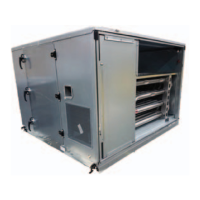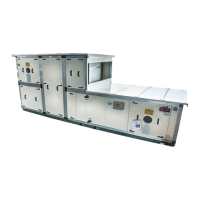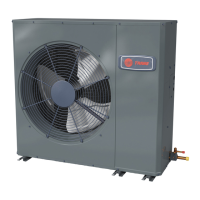Installation - Mechanical
CLCH-SVX010A-EN 17
Seismic restrictions will require the use of welding or
fasteners to secure unit to roof curb. Please refer to
submittal package for guidelines
All section perimeters must be continuously supported.
Failure to may result in door misalignment, leakage, and
incorrect or non-functioning drain pan operation.
Flat Concrete Pad
The base for concrete is designed to sit flat on the concrete
with full perimeter contact. Concrete pads should be
perfectly level, flat, and sized to the minimum exterior
base channel measurements.
Roof Curb for Large Unit with Shipping
Splits
Larger units with shipping splits may require full-width
intermediate support. With any raised type roof support
such as curbs or dunnage, provisions must be made to
carry the weight of the base cross members at the
sectional splits. Since these unit bases are designed with
lifting lugs between the sections, temporary support must
be provided so additional sections can be set down with a
12-inch gap to allow for working room between sections
and lug removal.The use of field-provided outriggers has
proven to be a successful way to accomplish this. Large
units may require additional metal in the roof curb. This is
to ensure the long span of perimeter unit structural
support will slide over and rest on the roof curb. Please call
factory for clarification if needed.See Figure 14.
Joining Sections Edge-to-Edge
Units must be installed level for proper drainage of
condensate from the drain pan. In addition, each section in
a multi-section unit must be properly supported.
Note: Leveling each section, beginning with the first, is
critical. Failure to level and align the sections
immediately creates greater misalignment or even
structural damage afterward.
1. Remove all crating and wrapping from the surfaces to
be joined.
2. Place one section of the air handler into the desired
position. Verify section is installed level front to back
and side to side. Verify section is square to support
structure, this is critical to insure proper alignment for
next adjoining sections.
3. Check squareness measuring the critical dimensions
given. Use preselected method to anchor first piece in
place. This is necessary so movement will not affect
pulling next sections into alignment.
4. When the unit is positioned and squareness is ensured
within 1/8-inch, remove all lifting lugs located along the
split plane.
5. After assuring positioning is correct, anchor in place
either by welding unit base to the curb or by
mechanical fasteners. The first section will be used to
pull remaining sections up tight so it’s critical that first
section be secured.
6. Install 2-inch to 4-inch x 1/4-inch neoprene gasket,
depending on casing thickness, to all mating surfaces
of the section, including any internal walls. This gasket
must be applied to the full perimeter of the section split
on both sections to be joined.
Figure 13. Flat concrete pad mount
Air handler
base structure
Concrete
pad
Figure 14. Field-supplied outriggers

